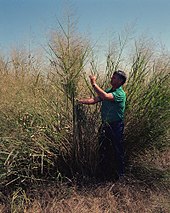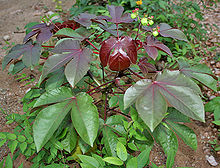Sustainable biofuels
Biofuels are fuels from plant materials. They could reduce the price of oil. Some biofuels can supply sustainable energy. Development of biofuels will help economic prospects in Africa, Latin America and Asia.[1][2][3]
Biofuel options
[change | change source]
Biofuels, such as ethanol and biodiesel, are produced from the products of conventional food crops such as the starch, sugar and oil feedstocks from crops that include wheat, maize, sugar cane, palm oil and oilseed rape. Any major switch to biofuels from such crops would create a direct competition with their use for food and animal feed, and in some parts of the world we are already seeing the economic consequences of such competition.[4]
Biofuels are now being produced from the cellulose in energy crops (perennial grasses such as switchgrass and Miscanthus giganteus), forestry materials, the co-products from food production, and domestic vegetable waste. Advances in the conversion processes[5] will improve the sustainability of biofuels, through better efficiencies and reduced environmental impact of producing biofuels, from both existing food crops and from cellulosic sources.[6]
Lord Ron Oxburgh suggests that responsible production of biofuels has several trade-offs:
Produced responsibly they are a sustainable energy source that need not divert any land from growing food nor damage the environment; they can also help solve the problems of the waste generated by Western society; and they can create jobs for the poor where previously were none. Produced irresponsibly, they at best offer no climate benefit and, at worst, have detrimental social and environmental consequences. In other words, biofuels are pretty much like any other product.[7]
According to the Rocky Mountain Institute, sound biofuel production practices would not hamper food and fibre production, nor cause water or environmental problems, and would enhance soil fertility.[8] The selection of land on which to grow the feedstocks is a critical component of the ability of biofuels to deliver sustainable solutions. A key consideration is the minimization of biofuel competition for prime cropland.[4][9]
Plants used as sustainable biofuel
[change | change source]Jatropha in India and Africa
[change | change source]
Crops like Jatropha, used for biodiesel, can thrive on marginal agricultural land where many trees and crops will not grow, or would produce only slow growth yields.[10][11] Jatropha cultivation provides benefits for local communities:
Cultivation and fruit picking by hand is labour-intensive and needs around one person per hectare. In parts of rural India and Africa this provides much-needed jobs - about 200,000 people worldwide now find employment through jatropha. Moreover, villagers often find that they can grow other crops in the shade of the trees. Their communities will avoid importing expensive diesel and there will be some for export too.[10]
Jatropha in Cambodia
[change | change source]Cambodia has no proven fossil fuel reserves, and is almost completely dependent on imported diesel fuel for electricity production. Cambodians face an insecure supply and pay some of the highest energy prices in the world. The impacts of this are widespread and may hinder economic development.[12]
Biofuels may provide a substitute for diesel fuel that can be manufactured locally for a lower price, independent of the international oil price. The local production and use of biofuel also offers other benefits such as improved energy security, rural development opportunities and environmental benefits. The Jatropha curcas species appears to be a particularly suitable source of biofuel as it already grows commonly in Cambodia. Local sustainable production of biofuel in Cambodia, based on the Jatropha or other sources, offers good potential benefits for the investors, the economy, rural communities and the environment.[12]
Sweet sorghum in India
[change | change source]Sweet sorghum overcomes many of the shortcomings of other biofuel crops. With sweet sorghum, only the stalks are used for biofuel production, while the grain is saved for food or livestock feed. It is not in high demand in the global food market, and thus has little impact on food prices and food security. Sweet sorghum is grown on already-farmed drylands that are low in carbon storage capacity, so concerns about the clearing of rainforest do not apply. Sweet sorghum is easier and cheaper to grow than other biofuel crops in India and does not require irrigation, an important consideration in dry areas.[13]
International collaboration on sustainable biofuels
[change | change source]Roundtable on Sustainable Biofuels
[change | change source]Public attitudes and the actions of stakeholders can play a crucial role in realising the potential of biofuels. Informed discussion and dialogue, based both on the scientific case and an understanding of public and stakeholder views, is important.[14] The Roundtable on Sustainable Biofuels is an international initiative which brings together farmers, companies, governments, non-governmental organizations, and scientists who are interested in the sustainability of biofuels production and distribution. During 2008, the Roundtable developed a series of principles and criteria for sustainable biofuels production through meetings, teleconferences, and online discussions.[15]
The Roundtable for Sustainable Biofuels released “Version Zero” of its proposed standards for sustainable biofuels on August 13, 2008. This includes a dozen principles, each with several criteria developing the principle further.[16]
Sustainable Biofuels Consensus
[change | change source]The Sustainable Biofuels Consensus is an international initiative which calls upon governments, the private sector, and other stakeholders to take action together..[17] It sees a landscape that provides food, fodder, fiber, and energy, which offers opportunities for rural development; that diversifies energy supply, restores ecosystems, protects biodiversity, and sequesters carbon.[17]
Oil price moderation
[change | change source]Biofuels offer the prospect of real market competition and lower oil prices. According to the Wall Street Journal, crude oil would be trading 15% higher and gasoline would be as much as 25% more expensive, if it were not for biofuels. A healthy supply of alternative energy sources will help to combat gasoline price spikes.[3][11]
Sustainable transport
[change | change source]Biofuels have a limited ability to replace fossil fuels and should not be regarded as a ‘silver bullet’ to deal with transport emissions. Biofuels on their own cannot deliver a sustainable transport system and so must be developed as part of an integrated approach, which promotes other renewable energy options and energy efficiency, as well as reducing the overall demand and need for transport. The development of hybrid and fuel cell vehicles, public transport, and better urban and rural planning all need to be considered.[18]
References
[change | change source]- ↑ The Royal Society (January 2008). Sustainable biofuels: prospects and challenges ISBN 978-0-85403-662-2, p. 61, Retrieved December 24, 2008.
- ↑ EPFL Energy Center (c2007). Roundtable on Sustainable Biofuels Archived 2011-07-10 at the Wayback Machine Retrieved December 24, 2008.
- ↑ 3.0 3.1 Gordon Quaiattini. Biofuels are part of the solution Archived 2013-01-02 at Archive.today Canada.com, April 25, 2008. Retrieved December 24, 2008.
- ↑ 4.0 4.1 The Royal Society (2008). p. 2. Retrieved December 24, 2008.
- ↑ Catherine Brahic. Hydrogen injection could boost biofuel production New Scientist, March 12, 2007. Retrieved December 24, 2008.
- ↑ The Royal Society (2008). p. 2 & 11.
- ↑ Ron Oxburgh. "Fuelling hope for the future." Courier Mail, August 15, 2007.
- ↑ Rocky Mountain Institute (2005). Winning the Oil Endgame Archived 2008-05-16 at the Wayback Machine p. 107. Retrieved December 24, 2008.
- ↑ Growing Sustainable Biofuels: Common Sense on Biofuels, part 2 Archived 2019-01-05 at the Wayback Machine World Changing, March 12, 2008. Retrieved December 24, 2008.
- ↑ 10.0 10.1 Ron Oxburgh. Through biofuels we can reap the fruits of our labours The Guardian, February 28, 2008. Retrieved December 24, 2008.
- ↑ 11.0 11.1 Patrick Barta. As Biofuels Catch On, Next Task Is to Deal With Environmental, Economic Impact Archived 2011-07-25 at the Wayback Machine Wall Street Journal, March 24, 2008. Retrieved December 24, 2008.
- ↑ 12.0 12.1 Andrew Williamson. Cambodian Research Centre for Development (c2005). Biofuel: A Sustainable Solution for Cambodia? Archived 2012-02-08 at the Wayback Machine Retrieved December 24, 2008
- ↑ Stephen Leahy. Can Sorghum Solve the Biofuels Dilemma? Archived 2012-02-20 at the Wayback Machine IPS News, May 13, 2008. Retrieved December 24, 2008.
- ↑ The Royal Society (2008). p. 4.
- ↑ EPFL Energy Center (2008). The Roundtable on Sustainable Biofuels: Ensuring Biofuels Deliver on their Promise of Sustainability December 4, 2008. Retrieved December 24, 2008.
- ↑ Roundtable for Sustainable Biofuels releases proposed standards for review Archived 2008-10-11 at the Wayback Machine Biomass Magazine, August 18, 2008. Retrieved December 24, 2008.
- ↑ 17.0 17.1 Sustainable Biofuels Consensus Archived 2013-05-03 at the Wayback Machine hosted by the Rockefeller Foundation Bellagio Center in Bellagio, Italy, March 24-28, 2008. Retrieved December 24, 2008.
- ↑ The Royal Society (2008). pp.1-3.